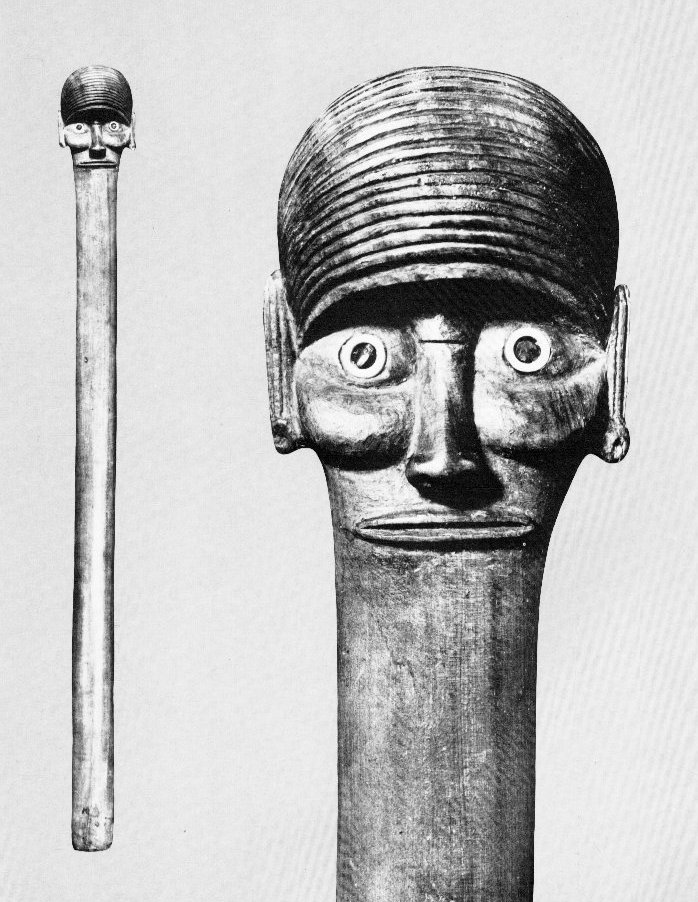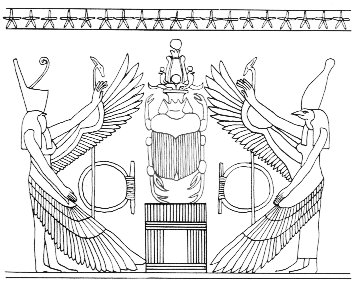|
TRANSLATIONS
We now will continue with the ua 'chapter' in the glyph dictionary:
Here the presumtive reader certainly will think 'Janus', the Roman god of the threshold. Does the ua glyph type represent the border between old year and 'January'? There are two sets of bent curves. Each such set could represent one of the years. A single set of 3 bent curves is like the 'fingers' in e.g. Ka3-14:
We should also remember how in Mamari there is some sort of opposite relationship between three fingers at the top of the arm and three toes at the bottom of the leg:
I inferred: 'If the 6 vae glyphs refer to winter solstice, then the 6 rima glyphs presumably refer to summer solstice.' At the end of the year we find vae glyphs and - according to my understanding of Mamari - at the end of the 1st half year we find rima glyphs. These two protecting limbs function as the wings in Egypt:
The change from one set of 'wings' to the other seems to occur at the solstices. Although, logically, it would rather be a change at the equinoxes, when sun is shifting from one hemisphere to the other, from one wife to the other. In the Egyptian picture the goddesses are located in north (left) and south (right) - with the little sun disc at top middle slightly offset to the right - which ought to mean a change at the equinoxes. Both rima and vae have the 'fingers' oriented towards right, i.e. towards the western horizon (and opposite to the 'eating gesture', kai). Both rima and vae suggest diminishing (light). Both suggest 'exit', 'going away'. The whole of ancient Egypt was located north of the equator, not so Polynesia. The Polynesians must have been acutely aware of how when passing the equator major changes took place. What was up became down and vice versa. In ancient Egypt the region around the north polar sky represented the region of death. For the Polynesians - if they wanted to keep an old structure where the dead resided at some definite place - then the west must be the rational choice. West is west also south of the equator. For the ancient Egyptians the north pole represented a region which did not disappear in the west but always was up above the horizon. In a way it was a region of eternal beings. For the Polynesians - who are locating 'death' in the west - it must have been natural to think of 'people' disappearing only temporally in the west to be 'reborn' later in the east. Ulu fell on his face, and therefore Mokuola could be 'reborn'. It is not be surprising to find the Pharaohs of ancient Egypt striving for eternal life, while the Polynesians instead are focused on their past - which lives on today. The rongorongo system of writing seems to put emphasis on half-years, with new year at winter solstice. The half-year seasons will then be symmetrical mirror-images of each other. The 'elbow' will half a year later be a 'knee'. The joints are the equinoxes. The 'hand' will half a year later be a 'foot'. Therefore, the orientation of ua glyhs ought to be accordingly, with rima fingers at the top and vae toes at the bottom:
The 'joint' between the two faces of the ua staff do not represent an equinox - there is no 'back of the head' on a ua staff. The ua glyph type follows the rule: The 'knee' is no equinox. Although oriented with 'open face' towards right the 'joint' agrees with the 'joint' of vae - forward there will be light, vaha mea is coming. We have earlier (when discussing mauga) found how ua glyphs may be oriented differently in different parallel texts:
The alternating black - red imagined for the glyphs led to a conclusion:
If we judge from the suggested origin - a fusion between rima and vae - then the present GD picture is correct. The reason for a reversed ua glyph at Ab4-70 is, maybe, that Ab4-68 is black and Ab4-69 red (implying that the next glyph must be black). Following mea (red) comes te ua roa:
I commented:
If my comments are sound, then the reason for a reversed ua at Ab4-70 should be that the 'rainy dark season' still is there (immediately beyond winter solstice). When Ure Honu seached for his stolen skull (of king Hotu Matua) he lifted up one side of the hare of Tuu Ko Ihu: ... When Tuu Ko Ihu came out and sat on the stone underneath which he had buried the skull, Ure Honu shot into the house like a lizard. He lifted up the one side of the house. Then Ure Honu let it fall down again; he had found nothing. Ure Honu called, 'Dig up the ground and continue to search!' The search went on. They dug up the ground, and came to where the king was. The king (was still) sitting on the stone. They lifted the king off to the side and let him fall. They lifted up the stone, and the skull looked (at them) from below. They took it, and a great clamour began ... I guess it was the east side of the hare of Tuu which Ure lifted (to let in the light), and that Ure represents the 1st half year (rima) while Tuu represents the 2nd half year - and of course Tuu must go (vae). As to the reversed ua in Pb2-30 we can look at the glyphs again:
I suggested that the two 'eyes' at Pb2-34 appeared because light had returned. Pb2-29 says by way of the number 29 and by way of the 'sails' at left that the new light is not yet there. Pb2-30 agrees - no light. The three birds (Pb2-31--33) must cover the turning over point:
Pb2-31--32 are of the same sort and they belong to the glyph type I have named tagata rere (the 'flying person'), while Pb2-33 is another sort. I have once classified the glyph as both moa and vae kore- birds are difficult to classify. If we regard Pb2-33 as moa it is clear that the light now returns. I cite the summary page:
I guess tagata rere is a glyph type showing by way of its two wings and frontal body position the 'apex' of the 'mountain'. We remember Aa1-15:
The head is not en face in any of the three glyphs, though, indicating the 'apex' is past. The two moon signs in Pb2-31--32 indicate - I guess - the 2nd half year (with moon taking over the rule from the sun at summer solstice). The tail in Pb2-33 may indicate how the 'last light' (the 'tail') is used to begin a new fire. |
||||||||||||||||||||||||||||||||||||||||||||||||||||||||||||||||||||||||||||||||||||||||||||||||||||||||||||||||||||||||||||||||||||||||||||||||||||||||||||||||||||||||||||||||||||||||||||||||||||||||||||||||||||||||||||||||||||||||||||||




























